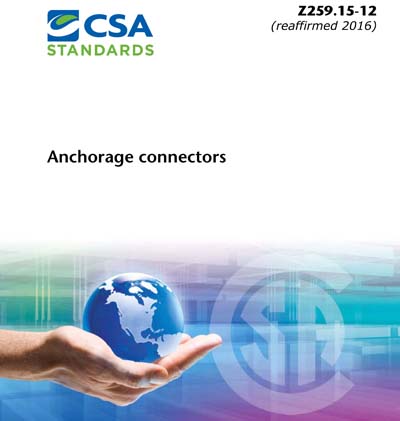Historical
CAN/CSA Z259.15-2012 (R2016)
CAN/CSA-Z259.15-12 - Anchorage connectors
Update #1 was published as notification that this is now a National Standard of Canada. To download any updates and/or register for email notification of future updates click here
Preface
This is the first edition of CSA Z259.15, Anchorage connectors. It is part of a series of Standards on components of fall-protection systems. This Standard specifies performance, design, testing, marking, classification, and other requirements related to anchorage connectors in travel restraint, fall arrest, work positioning, and suspended component/tie-back line systems.Scope
1.1 This Standard specifies performance, design, testing, marking, classification, and other requirements related to anchorage connectors in travel restraint, fall arrest, work positioning, and suspended component/tie-back line systems. 1.2 The requirements of this Standard include (where applicable) anchorage connectors attached to an anchorage. Methods of verifying the actual strength of anchorages in the field are not included. Note: See CSA Z259.16 for anchorage design and construction requirements. 1.3 This Standard does not differentiate between temporary, portable, and permanent anchorage connectors. 1.4 With the exception of multi-legged frames (e.g., tripods) and personnel davit arms, this Standard does not apply to ballasted, friction, counterweight, or vacuum anchorage connectors that rest on but are not fastened to an anchorage. Note: See CSA Z259.16 for requirements for some of these types of anchorage connectors. 1.5 This Standard does not apply to (a) equipment davit arms; (b) anchorage connectors that are custom engineered for limited or site-specific applications for fall protection; or (c) anchorage connectors that are custom engineered for suspended component/tie-back line applications only. Note: See CSA Z259.16 and CAN/CSA-Z271 for requirements for such anchorage connectors. 1.6 In CSA standards, shall is used to express a requirement, i.e., a provision that the user is obliged to satisfy in order to comply with the standard; should is used to express a recommendation or that which is advised but not required; and may is used to express an option or that which is permissible within the limits of the standard. Notes accompanying clauses do not include requirements or alternative requirements; the purpose of a note accompanying a clause is to separate from the text explanatory or informative material. Notes to tables and figures are considered part of the table or figure and may be written as requirements. Annexes are designated normative (mandatory) or informative (nonmandatory) to define their application. 1.7 The values given in SI units are the units of record for the purposes of this Standard. The values given in parentheses are for information and comparison only. Note: Where tolerance on any measured unit is otherwise not specified, it will be 1%.CSA America, Inc. [csa]

